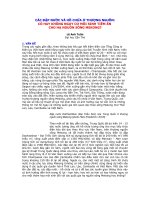Diversity ppt
Bạn đang xem bản rút gọn của tài liệu. Xem và tải ngay bản đầy đủ của tài liệu tại đây (905.75 KB, 40 trang )
1
3: Diversity
Fundamentals of Wireless Communication, Tse&Viswanath
3. Diversity
2
3: Diversity
Fundamentals of Wireless Communication, Tse&Viswanath
Main story
•
Communication over a flat fading channel has poor performance
due to significant probability that channel is in a deep fade.
•
Reliability is increased by providing more resolvable signal paths
that fade independently.
•
Diversity can be provided across time, frequency and space.
•
Name of the game is how to exploit the added diversity in an
efficient manner.
3
3: Diversity
Fundamentals of Wireless Communication, Tse&Viswanath
Baseline: AWGN Channel
BPSK modulation
Error probability decays exponentially with SNR.
4
3: Diversity
Fundamentals of Wireless Communication, Tse&Viswanath
Gaussian Detection
5
3: Diversity
Fundamentals of Wireless Communication, Tse&Viswanath
Rayleigh Flat Fading Channel
BPSK: Coherent detection.
Conditional on h,
Averaged over h,
at high SNR.
6
3: Diversity
Fundamentals of Wireless Communication, Tse&Viswanath
Rayleigh vs AWGN
7
3: Diversity
Fundamentals of Wireless Communication, Tse&Viswanath
Conditional on h,
When error probability is very small.
When error probability is large:
Typical error event is due to channel being in deep fade
rather than noise being large.
Typical Error Event
8
3: Diversity
Fundamentals of Wireless Communication, Tse&Viswanath
BPSK, QPSK and 4-PAM
•
BPSK uses only the I-phase.The Q-phase is wasted.
•
QPSK delivers 2 bits per complex symbol.
•
To deliver the same 2 bits, 4-PAM requires 4 dB more transmit power.
•
QPSK exploits the available degrees of freedom in the channel better.
•
A good communication scheme exploits all the available d.o.f. in the
channel.
9
3: Diversity
Fundamentals of Wireless Communication, Tse&Viswanath
Time Diversity
•
Time diversity can be obtained by interleaving and coding over
symbols across different coherent time periods.
Coding alone is not sufficient!
10
3: Diversity
Fundamentals of Wireless Communication, Tse&Viswanath
Example:GSM
•
Amount of time diversity limited by delay constraint and how fast
channel varies.
•
In GSM, delay constraint is 40ms (voice).
•
To get full diversity of 8, needs v > 30 km/hr at f
c
= 900Mhz.
11
3: Diversity
Fundamentals of Wireless Communication, Tse&Viswanath
Simplest Code: Repetition
After interleaving over L coherence time periods,
Repetition coding: for all
This is classic vector detection in white Gaussian
noise.
where and
12
3: Diversity
Fundamentals of Wireless Communication, Tse&Viswanath
Geometry
For BPSK
Is a sufficient statistic (match filtering).
Reduces to scalar detection problem:
13
3: Diversity
Fundamentals of Wireless Communication, Tse&Viswanath
Deep Fades Become Rarer
14
3: Diversity
Fundamentals of Wireless Communication, Tse&Viswanath
Performance
15
3: Diversity
Fundamentals of Wireless Communication, Tse&Viswanath
Beyond Repetition Coding
•
Repetition coding gets full diversity, but sends only one symbol
every L symbol times.
•
Does not exploit fully the degrees of freedom in the channel.
(analogy: PAM vs QAM)
•
How to do better?
16
3: Diversity
Fundamentals of Wireless Communication, Tse&Viswanath
Example: Rotation code (L=2)
where d
1
and d
2
are the distances between the codewords in the
two directions.
x
1
, x
2
are two BPSK symbols before rotation.
17
3: Diversity
Fundamentals of Wireless Communication, Tse&Viswanath
Rotation vs Repetition Coding
Rotation code uses the degrees of freedom better!
18
3: Diversity
Fundamentals of Wireless Communication, Tse&Viswanath
Product Distance
product distance
Choose the rotation angle to maximize the worst-case
product distance to all the other codewords:
19
3: Diversity
Fundamentals of Wireless Communication, Tse&Viswanath
Antenna Diversity
Receive
Transmit Both
20
3: Diversity
Fundamentals of Wireless Communication, Tse&Viswanath
Receive Diversity
Same as repetition coding in time diversity,
except that there is a further power gain.
Optimal reception is via match filtering
(receive beamforming).
21
3: Diversity
Fundamentals of Wireless Communication, Tse&Viswanath
Transmit Diversity
If transmitter knows the channel, send:
maximizes the received SNR by in-phase addition of
signals at the receiver (transmit beamforming).
Reduce to scalar channel:
same as receive beamforming.
What happens if transmitter does not know the channel?
22
3: Diversity
Fundamentals of Wireless Communication, Tse&Viswanath
Space-time Codes
•
Transmitting the same symbol simultaneously at the antennas
doesn’t work.
•
Using the antennas one at a time and sending the same symbol
over the different antennas is like repetition coding.
•
More generally, can use any time-diversity code by turning on one
antenna at a time.
•
Space-time codes are designed specifically for the transmit diversity
scenario.
23
3: Diversity
Fundamentals of Wireless Communication, Tse&Viswanath
Alamouti Scheme
Over two symbol times:
Projecting onto the two columns of the H matrix
yields:
•
double the symbol rate of repetition coding.
•
3dB loss of received SNR compared to transmit
beamforming.
24
3: Diversity
Fundamentals of Wireless Communication, Tse&Viswanath
Space-time Code Design
A space-time code is a set of matrices
Full diversity is achieved if all pairwise differences
have full rank.
Coding gain determined by the determinants of
Time-diversity codes have diagonal matrices and the
determinant reduces to squared product distances.
25
3: Diversity
Fundamentals of Wireless Communication, Tse&Viswanath
Cooperative Diversity
•
Different users can form a distributed antenna array to help each
other in increasing diversity.
•
Distributed versions of space-time codes may be applicable.
•
Interesting characteristics:
–
Users have to exchange information and this
consumes bandwidth.
–
Operation typically in half-duplex mode.
–
Broadcast nature of the wireless medium can be
exploited.









